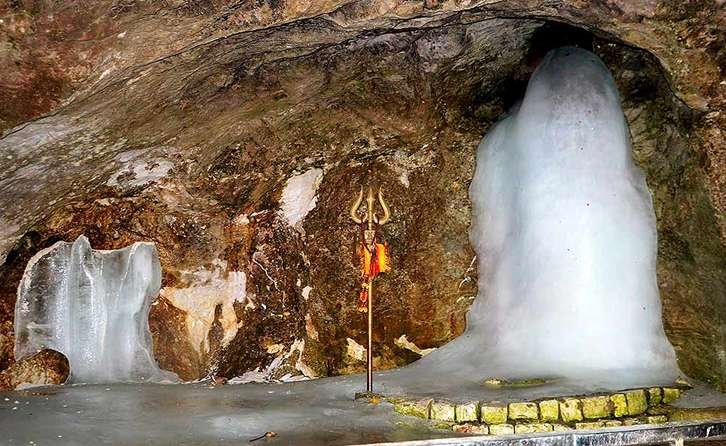Amarnath Yatra: A Spiritual Pilgrimage Amidst Challenging Weather and Stunning Scenery
The Amarnath Temple, locatedin the Indian Union territory of Jammu and Kashmir, is one of the most revered Hindu shrines dedicateto Lord Shiva. Situated at an altitude of 3,888 meters (12,756 feet) in the Himalayas, the temple is knowfor its natural ice lingam (a symbolic representation of Lord Shiva) that forms inside the cave during the pilgrimage season.
The Amarnath Temple holds great religious significance for Hindus. It is believedthat those who visit the shrine and pay their respects to Lord Shiva receive his blessings and attain salvation. The temple attracts millions of pilgrims from all over India and beyond, who undertake the challenging Amarnath Yatra, a pilgrimage to the cave, to seek the blessings of Lord Shiva.
The cave of Amarnath is believedto be over 5,000 years old and has been mention in ancient Hindu texts. According to mythology, it is saidthat Lord Shiva chose this cave to reveal the secret of immortality to his consort, Parvati. The ice lingam that forms inside the cave is consideredto be a divine manifestation of Lord Shiva’s presence and is highly reveredby the devotees.
The Amarnath Yatra, the pilgrimage to the Amarnath Cave, takes place during the summer months of July to August when the weather is relatively milder comparedto other times of the year. Pilgrims undertake the challenging journey on foot, covering a distance of approximately 46 kilometers (28.5 miles) from the base camps of Pahalgam or Baltal to the holy cave. The pilgrimage is knownfor its arduous trekking routes, challenging weather conditions, and breathtaking scenic beauty.
Natural Beauty of Amarnath Yatra
The Amarnath Temple is not only a place of religious significance but also a symbol of the rich cultural heritage of India. The pilgrimage to the holy cave is a unique blend of spirituality, adventure, and natural beauty, making it an unforgettable experience for those who undertake it. Despite the challenging weather and terrain, millions of devotees continue to undertake the Amarnath Yatra every year to seek the blessings of Lord Shiva and experience the divine aura of this sacred shrine.
Amarnath Yatra Weather and Temperature
The weather and temperature during the Amarnath Yatra can be extreme, especially due to the high altitude of the region. The pilgrimage takes place during the summer months of July to August, when the weather in the region is generally cold and unpredictable. The temperature during the Amarnath Yatra can vary greatly, ranging from sub-zero temperatures at night to moderately cool temperatures during the day.
At the higher altitudes of the Amarnath Yatra route, such as in Pahalgam and Baltal, the temperature can drop below freezing even during the day, and heavy snowfall can occur at any time. It is crucial for pilgrims to be well-prepare and carry appropriate warm clothing, including jackets, sweaters, and thermal wear, to protect themselves from the cold weather and stay comfortable during the pilgrimage.
Best Time to Visit and Places Near Amarnath Temple
The best time to visit the Amarnath Temple depends on the weather conditions and the official opening dates of the pilgrimage, which can vary from year to year. The months of July to August are generally consideredthe best time to undertake the Amarnath Yatra as the weather is relatively milder compare to other months. However, it is essential to be preparedfor the cold weather and fluctuating temperatures during the pilgrimage.
Apart from the Amarnath Cave, there are several other places of interest near the temple that pilgrims can visit during their journey. Pahalgam, located at the base camp of the Amarnath Yatra, is a picturesque hill station know for its stunning natural beauty and is often visitedby pilgrims as a part of their itinerary. Baltal, another base camp for the pilgrimage, is famous for its picturesque meadows and is often usedas a camping site by the pilgrims.
History of Amarnath Yatra
The history of the Amarnath Yatra dates back centuries and is shroudedin mythology and legend. According to Hindu mythology, the Amarnath Cave is believed to be the place where Lord Shiva narrated the secret of immortality to his consort, Parvati. The pilgrimage to the Amarnath Cave has been mentioned in ancient Hindu texts and has been an important pilgrimage site for Hindus for generations.
The modern-day Amarnath Yatra, as we know it, started gaining popularity in the 19th century when it was revived by a Kashmiri Pandit named Dayanand Saraswati. Since then, the Amarnath Yatra has grown in scale and attracts millions of devotees from all over India and beyond, who undertake the challenging pilgrimage to seek the blessings of Lord Shiva.
The Pilgrimage Journey
The Amarnath Yatra is a challenging pilgrimage that tests the physical and mental endurance of the pilgrims. The journey to the Amarnath Cave begins from the base camp in Pahalgam or Baltal, which are accessible by road from Srinagar, the capital city of Jammu and Kashmir. From the base camp, the pilgrims embark on a treacherous trek through the rugged terrain of the Himalayas, passing through snow-clad mountains, dense forests, and icy streams.
The traditional route from Pahalgam to the Amarnath Cave is approximately 46 kilometers long and takes about 3-4 days to complete. The pilgrims have to traverse steep mountain trails, cross freezing rivers, and face extreme weather conditions during their journey. Along the way, there are designate halting points or campsites where the pilgrims can rest and seek medical assistance if needed. The journey is physically demanding and requires adequate preparation, including physical fitness, acclimatization to high altitudes, and proper clothing.
Significance of Amarnath Yatra
The Amarnath Yatra holds great significance for the devotees of Lord Shiva, who consider it a divine calling to undertake this arduous pilgrimage. The journey to the Amarnath Cave is believed to cleanse the soul, bestow blessings, and fulfill the wishes of the pilgrims. It is also consideredan act of penance and devotion to seek the blessings of Lord Shiva and attain spiritual enlightenment.

Comments